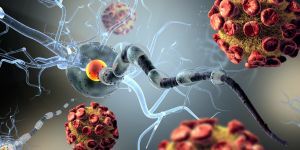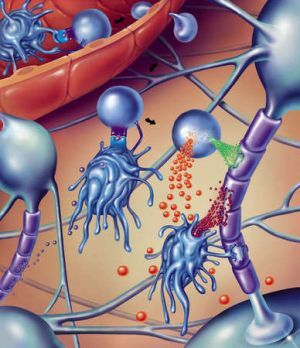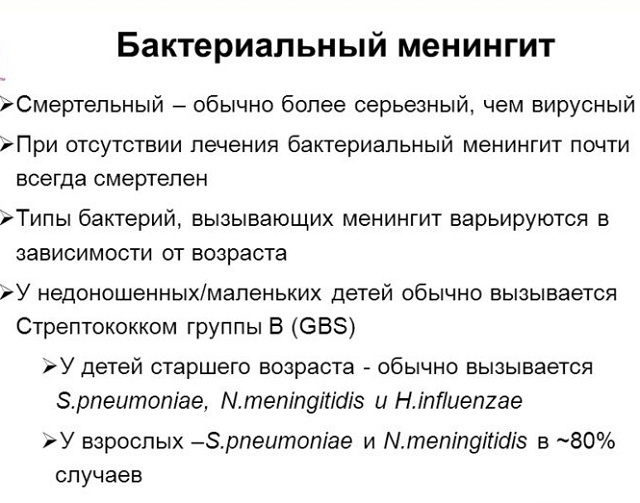 Disseminated encephalomyelitis is an acute inflammatory lesion of the central nervous system, which presumably has an autoimmune character.
Disseminated encephalomyelitis is an acute inflammatory lesion of the central nervous system, which presumably has an autoimmune character.
As a rule, this disease is a complication of a recently transferred infectious disease or develops as a result of immunization. To cope with this disease, it is very important to consult a doctor in time. The specialist will put an accurate diagnosis and choose adequate therapy.
Contents of
- Contents of the
- Disease
- Disturbances and points of the main stroke
- Causes and risk factors
- Complex of symptoms
- Diagnosis and approach to therapy
- Objectives of therapy
- Treatment methods
- Folk remedies
- Complications and consequences
- Warning and Armed!
The essence of the disease
Encephalomyelitis is considered a dangerous disease that combines the damage of the spinal cord and brain. In difficult cases, this ailment even leads to a fatal outcome. In this case, complete recovery can be observed. The prognosis depends on the activity of the abnormal process, the cause of the development of the disease, the adequacy of therapy.
It is currently accepted to distinguish two main forms of this pathology - primary and secondary encephalomyelitis. In the first case, the disease most often becomes a consequence of a viral infection. When secondary encephalomyelitis occurs, it is a complication of common infectious pathologies. It can also develop after the vaccination.
Types of violation and points of the main impact
Depending on the area of the lesions, these types of encephalomyelitis are distinguished:
- Encephalomyelopolyradiculoneuritis - is considered a fairly common form of the disease. It is accompanied by a violation of the
 functioning of almost all components of the nervous system.
functioning of almost all components of the nervous system. - Polyencephalomyelitis - this pathology is accompanied by disruption of the cranial nerves nuclei, which are located in the brain stem, as well as the damage to the gray matter of the spinal cord.
- Optoencephalomyelitis and optic ameliorate - these diseases have a similar pathogenesis. They are characterized by a combination of symptoms of damage to the optic nerves and disruption of the spinal cord and brain.
- Disseminated myelitis - accompanied by disruption of the spinal cord at various levels.
However, most often diffuse encephalomyelitis is diagnosed. This form of the disease is characterized by the appearance of lesions that affect different parts of the brain and spinal cord.
Causes and risk factors for
The causes of the development of disseminated encephalomyelitis have not been fully studied. Scientists are still wondering why the immune system begins to synthesize proteins aimed at fighting the neural tissue.
Nevertheless, the conducted studies allowed establishing some regularities. So, the disease most often progresses after such events:
- craniocerebral injury ;
- viral infections - especially those that cause the appearance on the skin of specific rashes. Such diseases include herpes, chicken pox, rubella;
- introduction of specific vaccines ;
- decrease in body reactivity ;
- allergy ;
- catarrhal diseases .
Complex of symptoms of
All manifestations of disseminated encephalomyelitis can be divided into 2 main categories - focal and cerebral. Thus, focal symptoms are represented by a significant variety of brain lesions. There are also certain combinations in the form of the following syndromes:
- pyramidal;
- cerebellar;
- extrapyramidal;
- oculomotor disorders.
 All these syndromes have a large number of manifestations, therefore only an expert can make an accurate diagnosis.
All these syndromes have a large number of manifestations, therefore only an expert can make an accurate diagnosis.
Another category of symptoms for disseminated encephalomyelitis are cerebral palsy. Without their presence, the diagnosis is questionable. Such manifestations include the following:
- the appearance of seizures of epilepsy ;
- impaired consciousness ;
- cognitive impairment - memory impairment, reduced intellectual capacity.
Both categories of symptoms appear within 1-2 weeks. Then the clinical picture becomes less pronounced.
Also, against the background of this process, certain symptoms of impaired peripheral nervous system functioning may appear. A fairly common condition is polyneuropathy.
Some people have initial signs that may be due to an infectious disease that caused disseminated encephalomyelitis, with fever and asthenia.
Diagnosis and approach to therapy
It is not too difficult to make an accurate diagnosis. Doctors usually perform magnetic resonance imaging of the brain with the use of contrast.
The clinical features of this ailment can easily be seen on the screen or pictures. If necessary, the doctor may prescribe a lumbar puncture.
The objectives of therapy
With the development of diffuse encephalomyelitis treatment should solve such problems:
- Elimination of the aggression of the immune system in relation to the nervous .It is very important to maintain or restore
 a normal immune response to ingestion of pathogenic microorganisms.
a normal immune response to ingestion of pathogenic microorganisms. - Maximum recovery of the work of the brain areas of , affected by the inflammatory process. To do this, use different ways to stimulate remyelination.
- Monitoring the state of immunity and correcting its functioning when deviations are detected. To find the right anti-inflammatory therapy, you need to examine the patient's immune status.
- Detection and treatment of infectious diseases .Due to this, it is possible to prevent the transformation of encephalomyelitis into multiple sclerosis. To prevent complications, once every six months you need to make control immunograms and check for infections.
Treatment methods
Basic therapy of the disease is carried out with the help of anti-inflammatory steroid agents. Depending on the complexity of a person's condition, high or medium doses of Prednisolone are used. As the symptoms of the disease develop, the volume of the drug substance is gradually reduced. Corticosteroid therapy should be continued for 2-5 weeks.
Etiological therapy for disseminated encephalomyelitis is carried out through antiviral drugs. For this purpose, analogues of Interferon are usually used.
In rare cases, bacterial origin of the disease uses antibacterial drugs. The doctor can prescribe Ampioks, Gentamycin, Kefzol. If the pathology develops against rheumatism, bicillinotherapy is indicated.
A mandatory component is symptomatic therapy. According to the indications, resuscitation, artificial ventilation of the lungs, restoration of hemodynamics can be carried out. If the disease is accompanied by cerebral manifestations, you need to pay attention to preventing brain edema. For this, Diakarb, Magnesia, Furosemide can be administered.
With pronounced dysphagia, probe nutrition is used. If a person experiences urinary retention, a catheter is inserted into the bladder.
 In the case of an intestinal paresis, enemas should be made. The convulsive syndrome is an indication for the appointment of anticonvulsants.
In the case of an intestinal paresis, enemas should be made. The convulsive syndrome is an indication for the appointment of anticonvulsants.
To cope with neurological disorders that often accompany the aggravation of disseminated encephalomyelitis, you need to use B vitamins, ascorbic acid, anticholinesterase drugs. They include Galantamine, Proserin. When spasms of muscle tissue shows the use of Midokalma.
During reconvalescence, it is necessary to use resorbants - Lidazu, Cerebrolysin.
Also in this period are nootropic drugs - Ginkgo biloba, Nootropil. In addition, doctors often prescribe neuroprotection - in particular, Semax or Mexidol.
To restore physical activity, you need to do massage and therapeutic gymnastics. A good effect is provided by transcranial magnetic stimulation.
During the exacerbation of encephalomyelitis, treatment is performed in a hospital setting. During this period, they use strong medicines, and therefore people's therapy is not applied.
Folk remedies for restoring the body
In the recovery phase, to maintain the nervous system, you can use effective recipes:
- Onion with honey .The bulb should be cleaned and grinded with a float. Squeeze the juice and mix in equal parts with honey. Use a small spoon three times a day. You need to do this before meals for a month.
- Mumiye .Literally, 5 g of the agent must be dissolved in 100 ml of water. Take a small spoon three times a day for an hour before eating.
- Shovel huntsman .To make the product you need to take 3 large spoons of fruits of this plant, pour 250 ml of boiling water and insist in a thermos for 12 hours. Drink a day in small portions. The course of treatment should be 2 months.
Complications and consequences of
Some patients have persistent symptoms that manifest themselves as paresis, visual impairment, or sensory disorders.
In some cases, disseminated encephalomyelitis is characterized by a severe course, the consequences of which result in bulbar disorders that can lead to death.
Warning and armed!
To prevent the development of the disease, it is necessary to adhere to such rules: 
- to avoid hypothermia and overheating during the vaccination period;
- to refuse from drinking during vaccinations;
- to avoid physical overloads during this period.
Disseminated encephalomyelitis is a very serious disease that can cause dangerous consequences. To avoid this, it is important to contact a doctor in a timely manner who will choose a comprehensive therapy.



